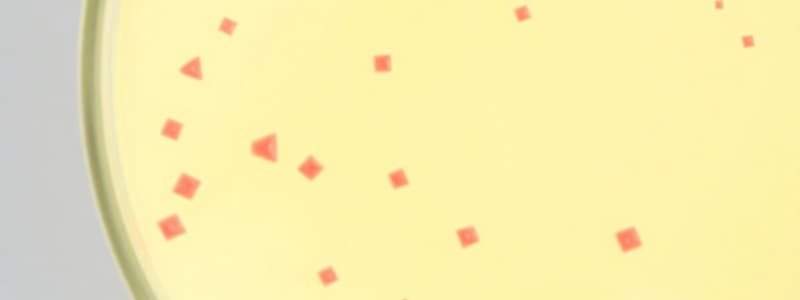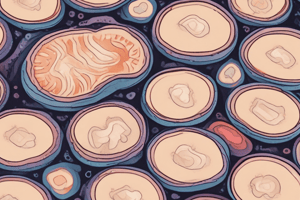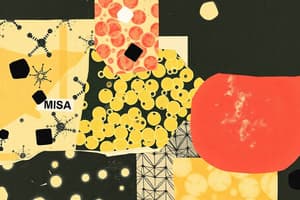Podcast
Questions and Answers
What two components in MacConkey agar help to inhibit Gram-positive bacteria?
What two components in MacConkey agar help to inhibit Gram-positive bacteria?
Bile salts and crystal violet dye.
What visual difference indicates lactose fermentation on MacConkey agar?
What visual difference indicates lactose fermentation on MacConkey agar?
Lactose fermenting organisms appear as red to pink colonies.
At what temperature and time should MacConkey agar be incubated?
At what temperature and time should MacConkey agar be incubated?
It should be incubated at 37°C for 24 hours.
Which microorganism is known to produce pink colonies on MacConkey agar?
Which microorganism is known to produce pink colonies on MacConkey agar?
What happens to lactose non-fermenting organisms on MacConkey agar?
What happens to lactose non-fermenting organisms on MacConkey agar?
MacConkey agar is used for the selective isolation of coliforms and enteric pathogens based on the ability to ferment ______.
MacConkey agar is used for the selective isolation of coliforms and enteric pathogens based on the ability to ferment ______.
The pink colonies on MacConkey agar indicate that the microorganism is capable of ______ fermentation.
The pink colonies on MacConkey agar indicate that the microorganism is capable of ______ fermentation.
MacConkey agar contains bile salts and crystal violet dye to inhibit most ______-positive bacteria.
MacConkey agar contains bile salts and crystal violet dye to inhibit most ______-positive bacteria.
The incubation of MacConkey agar is done aerobically at ______° C for 24 hours.
The incubation of MacConkey agar is done aerobically at ______° C for 24 hours.
On MacConkey agar, Escherichia coli produces ______ colonies due to lactose fermentation.
On MacConkey agar, Escherichia coli produces ______ colonies due to lactose fermentation.
Flashcards
MacConkey Agar purpose
MacConkey Agar purpose
Selective and differential medium for isolating and identifying coliforms and enteric pathogens.
MacConkey Agar selective action
MacConkey Agar selective action
Inhibits most Gram-positive bacteria using bile salts and crystal violet.
MacConkey Agar lactose fermenters
MacConkey Agar lactose fermenters
Appear pink/red due to lactose fermentation, changing the pH and triggering dye response.
MacConkey Agar lactose non-fermenters
MacConkey Agar lactose non-fermenters
Signup and view all the flashcards
MacConkey Agar growth conditions
MacConkey Agar growth conditions
Signup and view all the flashcards
What is MacConkey agar used for?
What is MacConkey agar used for?
Signup and view all the flashcards
What makes MacConkey agar selective?
What makes MacConkey agar selective?
Signup and view all the flashcards
What makes MacConkey agar differential?
What makes MacConkey agar differential?
Signup and view all the flashcards
How do lactose fermenters appear on MacConkey agar?
How do lactose fermenters appear on MacConkey agar?
Signup and view all the flashcards
How do lactose non-fermenters appear on MacConkey agar?
How do lactose non-fermenters appear on MacConkey agar?
Signup and view all the flashcards
Study Notes
MacConkey Agar Composition
- Contains bile salts to inhibit most Gram-positive bacteria, except Enterococcus and some Staphylococcus species (like S. aureus).
- Includes crystal violet dye, inhibiting some Gram-positive bacteria.
- Contains neutral red dye (pH indicator) that stains lactose-fermenting microbes.
- Contains lactose and peptone.
MacConkey Agar Preparation
- Dissolve 55g of MacConkey agar in 1000ml of distilled water by heating to boiling.
- Sterilize by autoclaving at 15lbs pressure and 121°C for 15 minutes.
- Cool the medium to 45-50°C before pouring into sterile Petri dishes.
MacConkey Agar Uses
- Selectively isolates, cultivates, and differentiates coliforms and enteric pathogens based on their ability to ferment lactose.
- Lactose fermenting organisms produce red to pink colonies.
- Lactose non-fermenting organisms appear as colorless or transparent colonies.
Microbial Growth Examples
- Escherichia coli: Produces pink colonies due to lactose fermentation.
- Proteus mirabilis: Forms colorless colonies, showing no spreading.
- Enterococcus sp.: Shows no growth.
Incubation Conditions
- Aerobic incubation at 37°C for 24 hours.
Studying That Suits You
Use AI to generate personalized quizzes and flashcards to suit your learning preferences.




